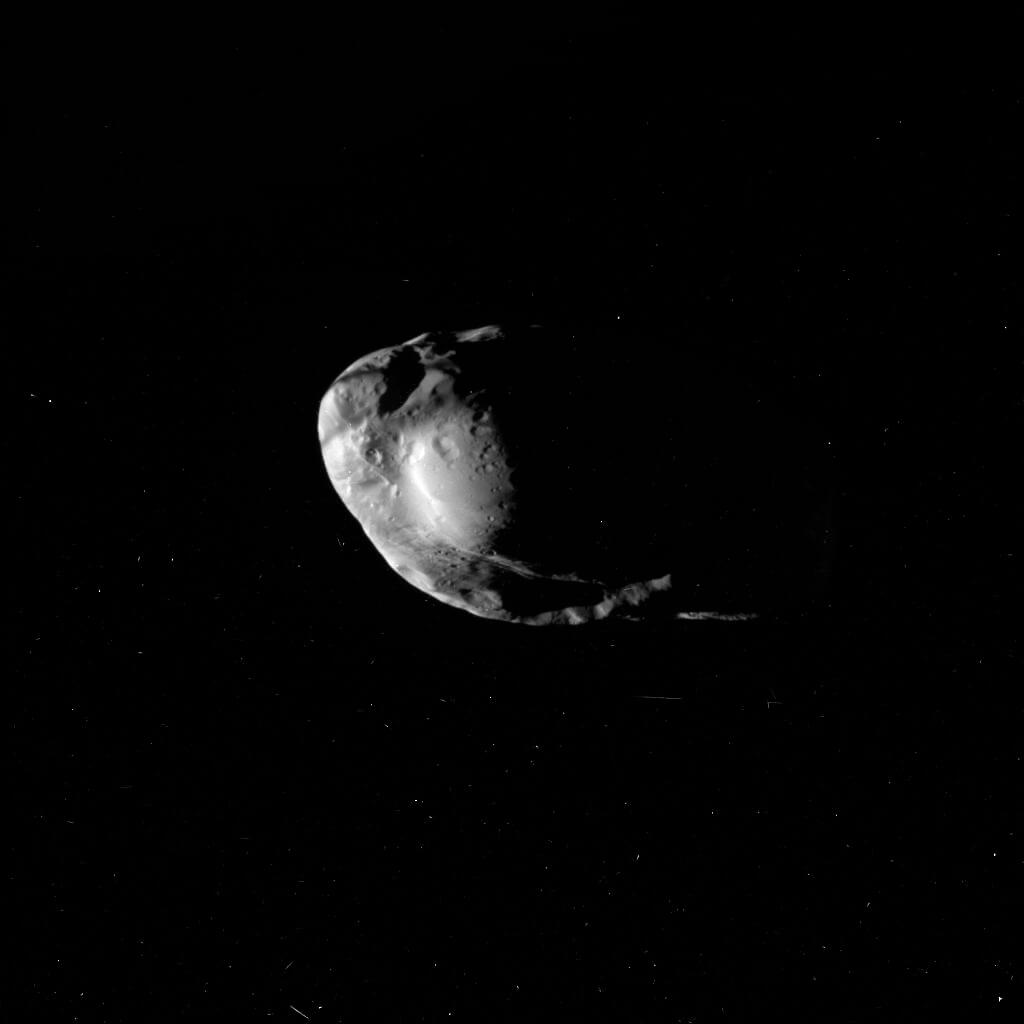One of these moons is Prometheus. It is an elongated moon whose dimensions are 58 X 79 X 136 km, its distance from Saturn is 139,353 km and its orbital period is 14.7 hours

Along with photographing Saturn's large moons by the Cassini spacecraft, some of the smaller moons were also photographed, those with a diameter of tens of kilometers and a few of them exceeding 100 kilometers in diameter. These are actually non-spherical bodies which, in terms of their composition and the appearance of their faces, can give clues about the asteroids themselves. No flybys near any of them were planned for the Cassini spacecraft. The working method was different. The spacecraft's cameras recorded everything that came into their field of view as it orbited Saturn, as it moved toward the large moons and as it left them. The survival of the spaceship was therefore great. This gives a broad perspective regarding Saturn, its rings and its moons.
One of these moons is Prometheus. It is an elongated moon whose dimensions are 58 X 79 X 136 km, its distance from Saturn is 139,353 km and its orbital period is 14.7 hours. The distances from which the moon was photographed by the Cassini ranged from 1,692,686 km to a distance of tens of thousands of kilometers. For example, on 26.12.2009 the moon was photographed from a distance of 59,000 km with a resolution of 351 meters per pixel (1). Another photo from January 28.1.2010, 34,000 was taken from a distance of 200 km with a resolution of 2 meters per pixel (20). The position of Prometheus is between the F ring and the A ring. Sometimes it is very close to the F ring. In this respect it belongs to the shepherd moons, those small moons that accompany this or that ring of Saturn. The moon is cratered, although the density of craters is not great and most of its surface, at least those photographed, are covered in dust. The largest of the craters are XNUMX km in diameter. Several ridges and valleys were also found.
Before the Cassini spacecraft arrived at Saturn and even after, the accepted assessment was that Prometheus during his movement around the planet showed him one side of his face like other moons. But his photographs from a distance show what is very interesting. In a photograph taken on 14.8.2008, its longitudinal axis is parallel to the F ring (3). In another photo from 14.11.2008 the width axis is parallel to the ring (4). In the photo taken on 26.5.2009/5/XNUMX, the moon is tilted at an angle relative to the ring (XNUMX). These photographs negate the assumption that was accepted among the researchers. The obvious conclusion is that the moon rotates around itself, in this case the longitudinal axis. Due to its gravitational force, even though it is a very tiny gravitational force, it attracts particles from the ring as it approaches it. Are these particles that create its dust layer and is the thickness of this layer uniform over the entire surface? In some of the close-up photos taken in high resolution, you can see that some of the craters are also covered in dust.
The footage that was broadcast to Israel shows something more about the orbit of Prometheus around Saturn. His collection of photographs can be divided into 3 groups. One example from each group will be shown here.
Photographs in which the moon is seen in the space between the rings (6).
Photographs in which the moon is seen close to the F ring (7).
Photographs in which the moon is almost swallowed inside this ring (8).
The deviations from the orbit towards the F ring, at least in the photographs broadcast to Israel so far, show that there is no deviation towards the A ring. If you combine the movement of Prometheus around its axis and its movement around Saturn, you get a very unusual movement compared to the other small moons. Another moon of Saturn with a chaotic orbit is Hyperion. It seems that it is worthwhile to do comparative studies between the orbits of these moons and it is also desirable to check why Prometheus does not approach the A ring?
Sources
1. Image: N00148981.jpg
http://saturn.jpl.nasa.gov/photos/raw/rawimagesdetails/index.cfm?imageIR-210228
2.PIA12593: Crate Spud
http://photojournal.jpl.nasa.gov/catalog/PIA12593
3. Image: N00118569.jpg
http://saturn.jpl.nasa.gov/multimedia/images/raw/rawimages-details.cfm?feiImagesID=166157
4. Image: N001124064.jpg
http://saturn.jpl.nasa.gov/multimedia/images/raw/rawimages-details.cfm?feiImagesID=174274
5. Image: N00136771.jpg
http://saturn.jpl.nasa.gov/multimedia/images/raw/rawimages-details.cfm?feiImagesID=192315
6 Image: N00082596.jpg
http://saturn.jpl.nasa.gov/multimedia/images/raw/rawimages-details.cfm?feiImagesID=109641
7. PIA08918: Shifting Strands
http://photojournal.jpl.nasa.gov/catalog/PIA08918
8. PIA06143 : Thieving Moon
http://photojournal.jpl.nasa.gov/catalog/PIA06143

5 תגובות
Harel,
Although it is already 2012, December 21st is almost a whole year away.
Why start being afraid now?
Is it possible that the eighth passenger lives there??
😉
Not mine 🙁
I only get a DNS error message
The last pictures are up
7. PIA08918: Shifting Strands
http://photojournal.jpl.nasa.gov/catalog/PIA08918
8. PIA06143 : Thieving Moon
http://photojournal.jpl.nasa.gov/catalog/PIA06143
The pictures are not uploading 🙁